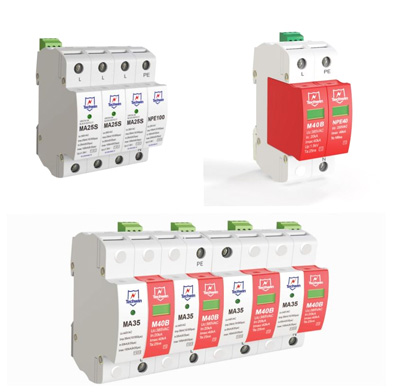
Surge Protective Devices (SPDs) are designed to protect electrical and electronic equipment from voltage spikes or surges. The three main types of SPDs are voltage-limiting type, switching type, and composite type. Each type has its own characteristics and practical applications:
Characteristics:
Operates by limiting the voltage across the protected equipment.
Diverts excess voltage to the ground to maintain a safe voltage level.
Typically uses components like metal oxide varistors (MOVs) to absorb and dissipate excess voltage.
Practical Applications:
Well-suited for protecting sensitive electronic equipment, such as computers, servers, and other devices with low voltage tolerance.
Commonly used in areas where a constant and stable power supply is crucial.
Ideal for locations with relatively stable power conditions, providing continuous protection against voltage spikes.
Characteristics:
Operates by switching between an open and closed state in response to surge conditions.
Allows current to flow only when a surge is detected, preventing continuous exposure to the protected equipment.
Often uses components like gas discharge tubes (GDTs) or thyristors for switching.
Practical Applications:
Effective in environments where surges are intermittent, and equipment can tolerate brief interruptions in power.
Commonly used in situations where low standby power consumption is critical, as it doesn't draw power during normal conditions.
Suitable for applications where there is a known history of occasional surges.
Characteristics:
Combines features of both voltage-limiting and switching technologies.
Offers continuous protection by limiting voltage and provides additional switching capability for surge events.
Typically incorporates a combination of MOVs, GDTs, or other components.
Practical Applications:
Provides a balanced approach to surge protection, offering both continuous and event-specific protection.
Suitable for a wide range of applications, offering versatility in surge protection strategies.
Often used in critical systems or areas where a combination of protection mechanisms is desired for comprehensive coverage.
In summary, the choice between voltage-limiting, switching, or composite type SPD depends on the specific characteristics of the electrical environment and the requirements of the equipment to be protected. The decision should take into account factors such as the sensitivity of the equipment, the nature of the power supply, and the frequency and magnitude of potential surge events in the area. Consulting with electrical professionals or engineers is crucial for a thorough assessment and selection of the most appropriate surge protection solution.
 Choosing the Right Power Surge Monitoring Device for Your HomeSeptember 11, 2023In an era where our homes are filled with a multitude of electronic devices, ensuring their safety and longevity is paramount. Power surges, often caused by electrical fluctuations or lightning strike...view
Choosing the Right Power Surge Monitoring Device for Your HomeSeptember 11, 2023In an era where our homes are filled with a multitude of electronic devices, ensuring their safety and longevity is paramount. Power surges, often caused by electrical fluctuations or lightning strike...view Important differences between IEC 61643-01:2024 and IEC 61643-11:2011: ---Interpretation of the new standard for surge protectorsDecember 12, 2024The surge protector is an electronic device that provides safety protection for various electronic equipment, instruments, and communication lines. According to its use, it can be divided into power s...view
Important differences between IEC 61643-01:2024 and IEC 61643-11:2011: ---Interpretation of the new standard for surge protectorsDecember 12, 2024The surge protector is an electronic device that provides safety protection for various electronic equipment, instruments, and communication lines. According to its use, it can be divided into power s...view How to Determine the Quality of a Surge Protector against Lightning?September 11, 2023The surge protector is in high demand in the current market and is required in many places. If you want to buy a better quality product, you must learn to judge the quality of the lightning-proof surg...view
How to Determine the Quality of a Surge Protector against Lightning?September 11, 2023The surge protector is in high demand in the current market and is required in many places. If you want to buy a better quality product, you must learn to judge the quality of the lightning-proof surg...view Types And Uses of Surge ProtectorsAugust 30, 20211. Types of Surge ProtectorsBased on working principle, surge protectors can be divided into voltage switch type, voltage limiting type and combined type.(1) Voltage switch surge protector. High imped...view
Types And Uses of Surge ProtectorsAugust 30, 20211. Types of Surge ProtectorsBased on working principle, surge protectors can be divided into voltage switch type, voltage limiting type and combined type.(1) Voltage switch surge protector. High imped...view Do Surge Protectors Stop Electrical Fires?May 14, 2025Surge protectors (SPDs) can effectively reduce the risk of electrical fires caused by surges when designed, installed and maintained in accordance with international standards (such as the IEC 61643 s...view
Do Surge Protectors Stop Electrical Fires?May 14, 2025Surge protectors (SPDs) can effectively reduce the risk of electrical fires caused by surges when designed, installed and maintained in accordance with international standards (such as the IEC 61643 s...view How to install a SPD?August 11, 2023Techwin surge protective devices (SPDs) are designed to protect electrical equipment from power surges. Installing an SPD is essential to ensuring the safety and longevity of your devices. Here is a s...view
How to install a SPD?August 11, 2023Techwin surge protective devices (SPDs) are designed to protect electrical equipment from power surges. Installing an SPD is essential to ensuring the safety and longevity of your devices. Here is a s...view